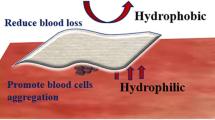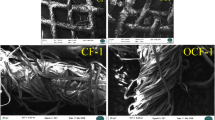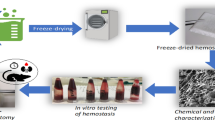Abstract
Massive hemorrhage is a frequent cause of human death in the operating room and other emergency situations. Therefore, effective hemostatic wound dressings are essential to save lives. Here we show that, calcium functioned carboxymethylated cotton fabric (MCF-Ca) conveniently prepared by carboxymethylation of cotton fabrics followed by treatment with calcium chloride solution could serve as an effective hemostatic wound dressing. The calcium content of MCF-Ca was determined as 18.11 ± 0.44 mg/g, and the calcium ions were released into a saline solution, a process that reached near-equilibrium within about 2 min. The biocompatible MCF-Ca promoted hemostasis via forming complexes with blood cells, and it showed lower blood clotting index as well as shorter blood clotting time comparing with unmodified CF in vitro. In addition, MCF-Ca exhibited better hemostatic efficiency than CF in vivo, resulting in much shorter hemostasis time and less blood loss in rat liver injury model and femoral artery animal model. In conclusion, MCF-Ca shows good potential to be used as wound dressing for patients with uncontrolled or massive hemorrhage.








Similar content being viewed by others
References
Behrens AM, Sikorski MJ, Kofinas P (2015) Hemostatic strategies for traumatic and surgical bleeding. J Biomed Mater Res Part A 102:4182–4194
Boulton F (2006) A hundred years of cascading-started by Paul Morawitz (1879-1936), a pioneer of haemostasis and of transfusion. Transfus Med 16:1–10
Bu Y et al (2016) Synthesis and properties of hemostatic and bacteria-responsive in situ hydrogels for emergency treatment in critical situations. ACS Appl Mater Interfaces 8:12674–12683
Chen J et al (2016) Preparation of a partially carboxymethylated cotton gauze and study of its hemostatic properties. J Mech Behav Biomed Mater 62:407–416
Chen J, Cheng W, Chen S, Xu W, Lin J, Liu H, Chen Q (2018) Urushiol-functionalized mesoporous silica nanoparticles and their self-assembly into a Janus membrane as a highly efficient hemostatic material. Nanoscale 10:22818–22829
Cheng F et al (2018a) Carbon nanotube-modified oxidized regenerated cellulose gauzes for hemostatic applications. Carbohyd Polym 183:246–253
Cheng H et al (2018b) Facile preparation of polysaccharide-based sponges and their potential application in wound dressing. J Mater Chem B 6:634–640
Cheng F et al (2019) Biodegradable N, O-carboxymethyl chitosan/oxidized regenerated cellulose composite gauze as a barrier for preventing postoperative adhesion. Carbohyd Polym 207:180–190
French AD (2017) Glucose, not cellobiose, is the repeating unit of cellulose and why that is important. Cellulose 24:4605–4609
Hickman DA, Pawlowski CL, Uds S, Marks J, Gupta AS (2017) Biomaterials and advanced technologies for hemostatic management of bleeding. Adv Mater 30:1700859
Hong Y et al (2019) A strongly adhesive hemostatic hydrogel for the repair of arterial and heart bleeds. Nat Commun 10:2060
Kim GH, Im JN, Kim TH, Lee GD, Youk JH, Doh SJ (2018) Preparation and characterization of calcium carboxymethyl cellulose/chitosan blend nonwovens for hemostatic agents. Text Res J 88:1902–1911
Kittinaovarat S, Hengprapakron N, Janvikul W (2012) Comparative multifunctional properties of partially carboxymethylated cotton gauze treated by the exhaustion or pad-dry-cure methods. Carbohyd Polym 87:16–23
Li G et al (2016) Graphene-montmorillonite composite sponge for safe and effective hemostasis. ACS Appl Mater Interfaces 8:35071–35080
Liang YP, Xu CC, Li GF, Liu TC, Liang JF, Wang X (2018) Graphene-kaolin composite sponge for rapid and riskless hemostasis. Colloid Surf B-Biointerfaces 169:168–175
Liu C et al (2019) A highly efficient, in situ wet-adhesive dextran derivative sponge for rapid hemostasis. Biomaterials 205:23–37
Lozano R et al (2012) Global and regional mortality from 235 causes of death for 20 age groups in 1990 and 2010: a systematic analysis for the Global Burden of Disease Study 2010. The Lancet 380:2095–2128
Marković D, Korica M, Kostić M, Radovanović Ž, Šaponjić Z, Mitrić M, Radetić M (2018) In situ synthesis of Cu/Cu2O nanoparticles on the TEMPO oxidized cotton fabrics. Cellulose 25:829–841
Morawitz P (1905) Die chemie der blutgerinnung. Ergebnisse Der Physiologie 4:307–422
Pourshahrestani S et al (2017) Potency and cytotoxicity of a novel gallium-containing mesoporous bioactive glass/chitosan composite scaffold as hemostatic agents. ACS Appl Mater Interfaces 9:31381–31392
Rubin HN, Neufeld BH, Reynolds MM (2018) Surface-anchored metal–organic framework–cotton material for tunable antibacterial copper delivery. ACS Appl Mater Interfaces 10:15189–15199
Sasaki K, Tenjimbayashi M, Manabe K, Shiratori S (2016) Asymmetric superhydrophobic/superhydrophilic cotton fabrics designed by spraying polymer and nanoparticles. ACS Appl Mater Interfaces 8:651–659
Thomas S (2000) Alginate dressings in surgery and wound management–Part 1. J Wound Care 9:56–60
Wang Y et al (2018a) Multifunctional chitosan/dopamine/diatom-biosilica composite beads for rapid blood coagulation. Carbohyd Polym 200:6–14
Wang Y, Kim K, Lee MS, Lee H (2018b) Hemostatic ability of chitosan-phosphate inspired by coagulation mechanisms of platelet polyphosphates. Macromol Biosci 18:1700378
Wang Y et al (2019) Chitosan-bound carboxymethylated cotton fabric and its application as wound dressing. Carbohyd Polym 221:202–208
Wu C-N, Fuh S-C, Lin S-P, Lin Y-Y, Chen H-Y, Liu J-M, Cheng K-C (2018) TEMPO-oxidized bacterial cellulose pellicle with silver nanoparticles for wound dressing. Biomacromol 19:544–554
Xia Q, Liu Z, Wang C, Zhang Z, Xu S, Han CC (2015) A biodegradable trilayered barrier membrane composed of sponge and electrospun layers: hemostasis and antiadhesion. Biomacromol 16:3083–3092
Xiao D et al (2017) Adipose-derived stem cells-seeded bladder acellular matrix graft-silk fibroin enhances bladder reconstruction in a rat model. Oncotarget 8:86471–86487
Xin Z, Guo B, Hao W, Liang Y, Ma PX (2018) Injectable antibacterial conductive nanocomposite cryogels with rapid shape recovery for noncompressible hemorrhage and wound healing. Nat Commun 9:166
Yu L, Shang X, Chen H, Xiao L, Zhu Y, Fan J (2019) A tightly-bonded and flexible mesoporous zeolite-cotton hybrid hemostat. Nat Commun 10:1932
Zhang Z et al (2018) Sandwich-like fibers/sponge composite combining chemotherapy and hemostasis for efficient postoperative prevention of tumor recurrence and metastasis. Adv Mater 30:1803217
Zhao X, Wu H, Guo B, Dong R, Qiu Y, Ma PX (2017) Antibacterial anti-oxidant electroactive injectable hydrogel as self-healing wound dressing with hemostasis and adhesiveness for cutaneous wound healing. Biomaterials 122:34–47
Zhu J, Li F, Wang X, Yu J, Wu D (2018a) Hyaluronic acid and polyethylene glycol hybrid hydrogel encapsulating nanogel with hemostasis and sustainable antibacterial property for wound healing. ACS Appl Mater Interfaces 10:13304–13316
Zhu T et al (2018b) Superhydrophobic/superhydrophilic Janus fabrics reducing blood loss. Adv Healthcare Mater 7:1701086
Acknowledgments
The authors thanks Zeju Yan and Rui Zhang for their contributions to this study. The present work is supported by the Fundamental Research Funds for the Central Universities (No. 2232020G-04), National Key R & D Program of China (No. 2018YFC1801502), the Fundamental Research Funds for the Central Universities and Graduate Student Innovation Fund of Donghua University (No. CUSF-DH-D-2020066), and the National Natural Science Foundation of China (No. 81900604).
Author information
Authors and Affiliations
Corresponding authors
Ethics declarations
Conflict of interest
The authors declare that they have no conflict of interest.
Additional information
Publisher's Note
Springer Nature remains neutral with regard to jurisdictional claims in published maps and institutional affiliations.
Rights and permissions
About this article
Cite this article
Wang, Y., Zhou, P., Xiao, D. et al. Calcium functioned carboxymethylated cotton fabric for hemostatic wound dressing. Cellulose 27, 10139–10149 (2020). https://doi.org/10.1007/s10570-020-03479-x
Received:
Accepted:
Published:
Issue Date:
DOI: https://doi.org/10.1007/s10570-020-03479-x




